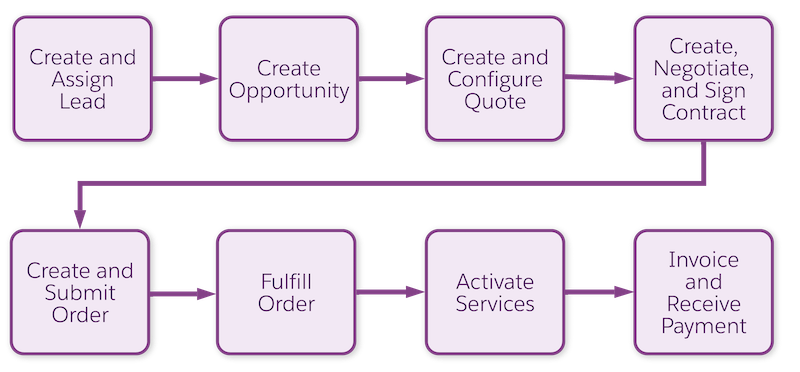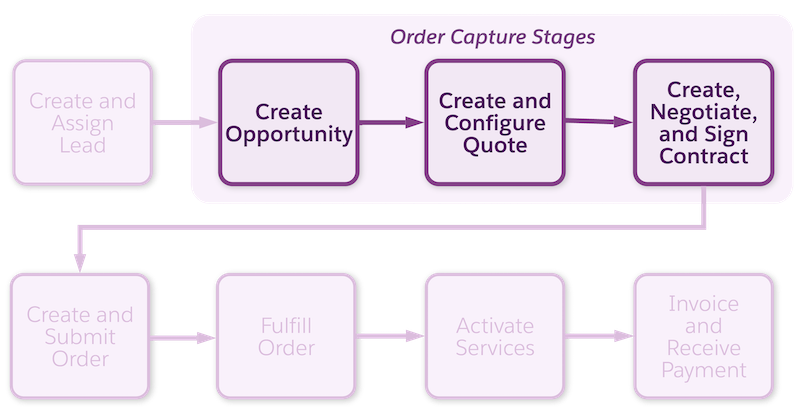Explore Order Capture Flows
Learning Objectives
After completing this unit, you’ll be able to:
- Summarize the main phases in a typical sales cycle.
- Identify the key systems and roles involved in the sales cycle.
- Explain the differences between the business-to-consumer (B2C) order-capture flow and the business-to-business (B2B) order-capture flow.
The Sales and Delivery Cycle
Let’s start by reviewing a typical sales, delivery, and billing cycle, including where Industries CPQ gets involved. Review the diagram, and then read the description of each stage.

- Create and Assign Lead: Create a lead in Sales Cloud to add the details of a potential customer, and then allocate the lead to a salesperson.
- Create Opportunity: The salesperson receives a notification and follows up by contacting the lead. If the lead presents an opportunity for a sale, the salesperson converts it into an account. An opportunity is recorded on the account, outlining details of the potential sale. At this point, the order-capture system may perform initial customer verifications, such as a credit check.
- Create and Configure Quote: The salesperson creates a quote from the opportunity on the account using Industries CPQ. The salesperson ensures the items in the quote meet customer requirements, are deliverable to the customer, and that the pricing is accurate before presenting the quote to the customer.
- Create, Negotiate, and Sign Contract: The customer is happy with the quote, so the salesperson uses Industries CPQ and Contract Lifecycle Management (CLM) integration to create a formal, legally binding contract. Next, during negotiation, the sales rep and customer agree on the terms of the contract, at which point both parties approve and sign the document.
- Create and Submit Order: The salesperson creates an order using Industries CPQ. The technical team may add further details, such as required resource attributes. The salesperson then submits the order to the order management system.
- Fulfill Order: Industries Order Management receives the commercial order from Industries CPQ. The app then passes the required technical information to the appropriate fulfillment systems for delivery. The order management system flags any problems for the fulfillment team to resolve.
- Activate Services: Using Service Cloud, customer service and installation teams can support delivery and installation of the products and services for the customer. Provisioning systems automate any service activation tasks.
- Invoice and Receive Payment: The customer receives an invoice for the goods and services and pays for them. The accounts department manages these aspects of the process using the billing system, but the customer services team may also query billing statuses and take payments.
Now, let’s quickly test your knowledge of the order-capture process. Put the following steps in the correct order.
Order Capture Stages
You now have the big picture of a typical sales and delivery cycle with Salesforce solutions. Let’s zoom into the order-capture process, which include stages 2, 3, and 4: creating the opportunity, quote, and contract. As you learned in the last unit, the sales process can cause headaches for various reasons, including inaccurate orders, slow approval processes and development times, and complexity caused by disparate systems. Surely, there must be a better way… enter Industries CPQ!
As you learned in the last unit, the sales process can cause headaches for various reasons, including inaccurate orders, slow approval processes and development times, and complexity caused by disparate systems. Surely, there must be a better way… enter Industries CPQ!
CPQ Order Capture
Use Industries CPQ to streamline the order-capture stages of your sales cycle. This way, sales teams use customer-context information to filter the products available from the product catalog and show only those appropriate for the customer. In addition, teams can make informed decisions based on availability and eligibility when building the customer’s solution. Industries CPQ applies the correct pricing to the quote, and then passes it to the customer for approval. Once the customer approves the quote, Industries CPQ creates and submits an order to the order management system.
This is just one way to set up your sales and delivery process, namely using Sales Cloud, Industries CPQ, CLM, Industries OM, and Service Cloud. Bear in mind, it’s not the same for all customers. The process depends on whether you’re selling to consumers (B2C) or businesses (B2B). Why? Let’s look at some reasons and examples.
|
Type of Order
|
Example
|
|---|---|
|
B2C orders usually involve fewer decision-makers than B2B orders, which means the sales cycle is often shorter for B2C orders. B2C orders also tend to be smaller than B2B orders, and B2C customers are generally more flexible and prone to impulse purchases. |
A consumer shops for and configures a home internet bundle. This order requires very few components, and because the pricing of the configuration is adequate for most customers, the sale doesn’t require negotiation or approval. |
|
B2B orders are generally more complex, and customers tend to have more formal processes for purchasing decisions. |
A medium-size business requests a quote for mobile phones for all employees. This large order requires the fulfillment of many devices and data plans and delivery to several different locations. The customer and company determine the bulk price of the order through extensive negotiation. |
Let’s take a closer look at how these differences impact the order-capture flow.
The B2C Order-Capture Flow
The B2C order flow happens when your organization sells to an individual consumer. Sales executives working with B2C customers tend to have responsibility for many more customers than account executives who work with B2B customers. B2C customers often order directly for themselves using a self-service portal such as a web store. Therefore, the lead, opportunity, and quote process are often missed altogether from the B2C order flow. Generally, the B2C order flow looks like this:

| Account | Order | Asset |
|---|---|---|
|
The sales rep opens an account for the customer. If it’s a new customer, they perform a credit check, and if the check is successful, create a new account. |
The sales rep creates an order on the customer account. They add products and services to the order and configure them to suit the customer’s requirements. They then review the order and submit it to the order management system. |
Order management teams fulfill the order and record details of the delivered products and services as assets on their account. Sales reps may make changes to customer assets using change orders. |
The B2B Order-Capture Flow
Sophia has a great relationship with a long-standing customer, Global Media. Linda from Global Media calls Sophia to say they’re opening two new stores and exploring technology options.
Generally, account executives familiar with the customer’s line of business are responsible for B2B order capture. They build relationships with their business customers and spend time managing the lifecycle of the order-capture flow.
Sophia jumps at the chance to step into the role of account executive for Global Media, so she can try out Industries CPQ. What steps should she take? Click each object icon to find out more.
Wrap Up
Now you know the difference between B2C and B2B order-capture flows.
- B2C customers have shorter sales cycles and simpler orders, so they tend to skip the quote phase of the order-capture process. The key objects used in B2C order-capture flows are accounts, orders, and assets.
- B2B customers have larger, more complex orders and may want multiple quotes before they decide on configuration and pricing. Therefore, the sales cycle is often much longer and more complex than for B2C customers. It’s common for the B2B order-capture flow to include leads, accounts, opportunities, quotes, orders, and assets.
To learn more about the key differences between B2B and B2C customers, take a look at the Salesforce blog post included in the resources. Next, you’ll learn how to locate and review each of the elements in the order-capture cycle.
Resources
Salesforce Blog: What Are the Differences Between B2C and B2B Marketing?